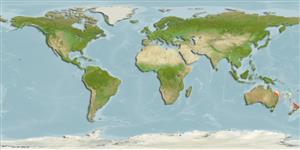Environment: milieu / climate zone / depth range / distribution range
Ecologia
marino benthopelagico; distribuzione batimetrica 10 - 450 m (Ref. 9563). Subtropical; 19°S - 41°S, 148°E - 178°W
Western Pacific: eastern Australia from western Bass Strait and northeastern Tasmania to Moreton Bay, Queensland. Also found in New Zealand; recently recorded from the Chesterfield Islands and New Caledonia (Ref. 9833).
Length at first maturity / Size / Peso / Age
Maturity: Lm 22.5, range 20 - 25 cm
Max length : 51.0 cm SL maschio/sesso non determinato; (Ref. 33987); peso massimo pubblicato: 2.0 kg (Ref. 9833)
Spine dorsali (totale) : 6 - 7; Raggi dorsali molli (totale) : 11 - 13; Spine anali: 4; Raggi anali molli: 12; Vertebre: 24.
Occur on rocky reefs and muddy substrates of the continental shelf and upper slope, forming dense schools close to the bottom at dawn and dusk and dispersing throughout the water column at night to feed (Ref. 9563). Juveniles also aggregate in schools (Ref. 33987) and are found in estuaries and shallow costal waters (Ref. 9833). Feed on small fish, crustaceans and mollusks (Ref. 27111).
Life cycle and mating behavior
Maturità | Riproduzione | Deposizione | Uova | Fecundity | Larve
Paxton, J.R., 1999. Berycidae. Alfonsinos. p. 2218-2220. In K.E. Carpenter and V.H. Niem (eds.) FAO species identification guide for fishery purposes. The living marine resources of the WCP. Vol. 4. Bony fishes part 2 (Mugilidae to Carangidae). FAO, Rome. (Ref. 9833)
IUCN Red List Status (Ref. 130435: Version 2024-1)
Threat to humans
Harmless
Human uses
Pesca: commerciale
Strumenti
Special reports
Download XML
Fonti Internet
Estimates based on models
Preferred temperature (Ref.
123201): 14.1 - 20.5, mean 15.9 °C (based on 22 cells).
Phylogenetic diversity index (Ref.
82804): PD
50 = 0.5088 [Uniqueness, from 0.5 = low to 2.0 = high].
Bayesian length-weight: a=0.01122 (0.00514 - 0.02450), b=3.04 (2.87 - 3.21), in cm total length, based on all LWR estimates for this body shape (Ref.
93245).
Trophic level (Ref.
69278): 3.8 ±0.59 se; based on food items.
Generation time: 14.7 ( na - na) years. Estimated as median ln(3)/K based on 2
growth studies.
Resilienza (Ref.
120179): Medio, tempo minimo di raddoppiamento della popolazione 1.4 - 4.4 anni (K=0.25; tm=4; tmax=16).
Prior r = 0.43, 95% CL = 0.28 - 0.64, Based on 1 data-limited stock assessment.
Fishing Vulnerability (Ref.
59153): High to very high vulnerability (70 of 100).
Climate Vulnerability (Ref.
125649): High vulnerability (64 of 100).
Nutrients (Ref.
124155): Calcium = 41.4 [12.4, 125.0] mg/100g; Iron = 0.724 [0.333, 1.367] mg/100g; Protein = 17.8 [16.8, 18.9] %; Omega3 = 0.431 [0.177, 0.992] g/100g; Selenium = 41.3 [21.8, 78.9] μg/100g; VitaminA = 20.2 [6.8, 63.7] μg/100g; Zinc = 0.733 [0.506, 1.093] mg/100g (wet weight);
